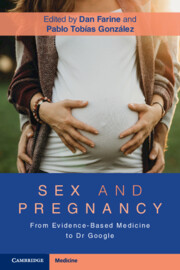Book contents
- Sex and Pregnancy
- Sex and Pregnancy
- Copyright page
- Dedication
- Contents
- Contributors
- Preface
- Section 1 General Issues
- Section 2 Specific Issues
- Chapter 9 Sex and Assisted Reproductive Technologies
- Chapter 10 The Male Partner’s Perspective
- Chapter 11 Sex in the First Trimester
- Chapter 12 Sex in the Second and Third Trimesters
- Chapter 13 Sex with Bleeding in the First Trimester
- Chapter 14 Sex with Bleeding in the Second and Third Trimesters
- Chapter 15 Short Cervix and Sex
- Chapter 16 Preterm Birth and Sex
- Chapter 17 Multiple Pregnancies and Sex
- Chapter 18 Special Pregnancies and Sex
- Chapter 19 Air Embolism Related to Sex in Pregnancy and the Postpartum
- Chapter 20 Pelvic and Ovarian Masses during Pregnancy
- Chapter 21 Sexually Transmitted Infections and Pregnancy
- Chapter 22 Sex for Induction of Labor
- Chapter 23 Nipple Stimulation during Pregnancy
- Chapter 24 Sex during the Postpartum
- Chapter 25 Sex after Pelvic Floor Injuries
- Chapter 26 Miscarriages, Spontaneous Abortions, Stillbirths, and Sex
- Index
- References
Chapter 22 - Sex for Induction of Labor
from Section 2 - Specific Issues
Published online by Cambridge University Press: 09 November 2022
- Sex and Pregnancy
- Sex and Pregnancy
- Copyright page
- Dedication
- Contents
- Contributors
- Preface
- Section 1 General Issues
- Section 2 Specific Issues
- Chapter 9 Sex and Assisted Reproductive Technologies
- Chapter 10 The Male Partner’s Perspective
- Chapter 11 Sex in the First Trimester
- Chapter 12 Sex in the Second and Third Trimesters
- Chapter 13 Sex with Bleeding in the First Trimester
- Chapter 14 Sex with Bleeding in the Second and Third Trimesters
- Chapter 15 Short Cervix and Sex
- Chapter 16 Preterm Birth and Sex
- Chapter 17 Multiple Pregnancies and Sex
- Chapter 18 Special Pregnancies and Sex
- Chapter 19 Air Embolism Related to Sex in Pregnancy and the Postpartum
- Chapter 20 Pelvic and Ovarian Masses during Pregnancy
- Chapter 21 Sexually Transmitted Infections and Pregnancy
- Chapter 22 Sex for Induction of Labor
- Chapter 23 Nipple Stimulation during Pregnancy
- Chapter 24 Sex during the Postpartum
- Chapter 25 Sex after Pelvic Floor Injuries
- Chapter 26 Miscarriages, Spontaneous Abortions, Stillbirths, and Sex
- Index
- References
Summary
The relationship between sexual intercourse and its role in onset of spontaneous labor has been questioned for decades. Intercourse for the induction of labor is regarded by many as a “natural” method for initiating labor. Possible physiological explanations for this include prostaglandin action of sperm, oxytocin production via breast/nipple stimulation, and direct mechanical effect of sex on uterine contractions. This chapter reviews the most current literature on these theories and whether increasing the frequency of sexual intercourse hastens the onset of spontaneous labor. Limitations of the recent literature and internet/social media sources are also highlighted in detail. Other alternative and popularized “natural” methods of inducing labor, such as physical activity, acupuncture, and herbal remedies, are also analyzed. Ultimately, most robust studies reveal there is no evidence to suggest that sex at term has an effect on spontaneous onset of labor or adverse outcomes of pregnancy. Simultaneously, there are no known harmful consequences in engaging in sexual activity for those patients with low-risk pregnancies.
- Type
- Chapter
- Information
- Sex and PregnancyFrom Evidence-Based Medicine to Dr Google, pp. 165 - 172Publisher: Cambridge University PressPrint publication year: 2022



